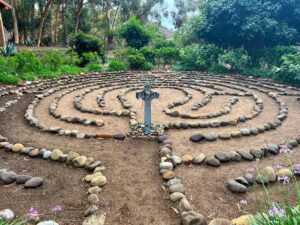The Reverend Jenifer M. Chatfield

Labyrinth, Serra Retreat Center Malibu, CA
Constance FitzGerald is a theologian and a member of the Carmelite community in Baltimore. She is influential because of her reflections on the importance of contemplation and the viability of seeking wisdom from Christian mystics from our tradition and interpreting this wisdom for a today’s spirituality. In her view, no longer should spirituality or contemplative practices be seen as only for those who step away from the world, or for those who only wish to live in some interior space separated from the world. Nor should spirituality be seen as something that is for those with too much time on their hands or for those who cannot rationally control their own destiny. Spiritual does not mean non-physical. A spiritual life means living a life in the Spirit. Living a life in the Spirit means that we live an integrated life, a non-fractured life, a life in truth and a life that is concerned with the other. As we focus our desire toward God, we become more whole and will have a desire to care for others. As we thrive, others should thrive. How do we begin living a life in the Spirit? Sometimes it is about surrender and letting go—Stop planning. Many times we must admit that we are not always in control and make the space for new inspiration and revelation. Ultimately it is about trust that God is there to reveal!
Saturday May 6th, 2023 was World Labyrinth Day. What is a Labyrinth exactly? First and foremost a labyrinth is not a maze. When you enter a maze you are tasked with a puzzle and must find your way out through logic and through trial and error. A Labyrinth, on the other hand, is a single path that takes you to a center and then back out without analysis or planning. The key factor is you can’t get lost and there is a freedom in trusting the path that you are on. A labyrinth is a pattern in the shape of a circle. According to scholars, the circular sacred design dates back to 2500 BCE and is found in many cultures. Walking a labyrinth is a form of meditation and can be found in churches, cathedrals and many outdoor spaces around the world. The most famous labyrinth is found in Chartres Cathedral just outside of Paris, which was constructed in the early 13th century. Labyrinth’s were seen as pilgrimage. Pilgrimage has always been a part of religious practice and has been an important feature of pre-Christian expression. In ancient Judaism, people would make a pilgrimage to the temple in Jerusalem. Early Christians also made pilgrimages to Jerusalem to visit holy sites which marked Jesus’ life, death and resurrection. Pilgrimages to the graves of saints or to other sacred spaces were common in medieval Europe. Pilgrimage has always been thought of as a way to facilitate spiritual transformation. The three phases of pilgrimage, according to scholars, requires leaving home, experiencing uncertainty in a new place (this is called being in a liminal space), and then returning home transformed because of the experience. When we are out of our comfort zones, we can grow spiritually because we aren’t relying on sameness to get us through the day. Over time, pilgrimages became more and more difficult so labyrinths were created to simulate a sacred pilgrimage journey.
The symbolic meaning of walking a labyrinth can be described as a journey of the soul moving toward God. The journey begins at the mouth or entrance, with movement toward a center. Dr. Sheryl A Kujawa-Holbrook in her book Pilgrimage The Sacred Art: Journey to the Center of the Heart describes the healing properties of walking a labyrinth: “Scientific research has shown that walking labyrinths has a positive effect on overall health and is an effective method of stress reduction.”[1] She says that walking clears our minds and increases our awareness of the moment and leaves us open for experiencing presence. Walking a labyrinth is a way to slow down, reflect and literally move to the center of our being where spiritually speaking we can meet God. Perhaps the most important aspect of walking a labyrinth is to enter with an open-mind and without expectations. When we can trust that the path we are taking will guide us in the right direction, we can much more easily reflect, have gratitude in the moment, or hear something new that we need to hear.
The practice goes like this: As one walks the labyrinth, it is sometimes helpful to bring up in your mind something that is on your heart. If you are anxious about something, lift up your anxiety to God. Give up thinking about it or trying to solve it. Continue to walk slowly and deliberately and see what comes up for you. Open yourself up to the presence of God with each step. Don’t rush. When you reach the center, spend some time there and ask God to be present in your mind and to convert your heart. As you follow the path out, continue giving time for reflection and leave room in your heart and mind for inspiration. Each person’s experience will be different.
In our time, living in the Spirit is more important than ever. Old ways of doing things and the institutions we have relied on for most of our lives seem to be in question or dismissed. Technology is moving at a rapid pace and the world that humans have created is a world that is ironically hard for most humans to keep up with. We have no choice but to make space for God to help us on the journey. The labyrinth is one way to find our center.
See this recent LA Times article for local Labyrinth inspiration!
[1] Dr. Sheryl A. Kujawa-Holbrook. Pilgrimage: Journey to the Cener of the Heart (Woodstock: Skylight Paths, 2013)127.

